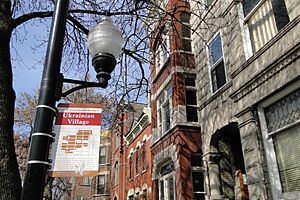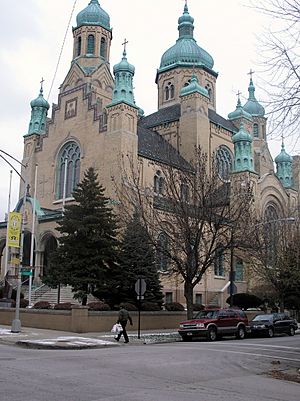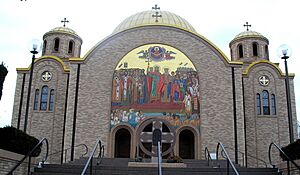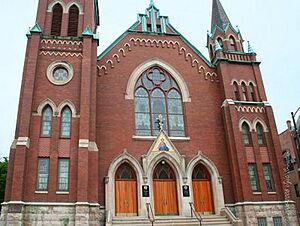Ukrainian Village, Chicago facts for kids
Ukrainian Village is a special neighborhood in Chicago, Illinois. It's located on the city's west side. This area is known for being home to many people of Ukrainian heritage. It's a central place for nearly 70,000 Ukrainians living in the wider Chicago area. The neighborhood's borders are Division Street to the north, Grand Avenue to the south, Western Avenue to the west, and Damen Avenue to the east. It's part of the larger West Town community.
Contents
Discover the History of Ukrainian Village
Ukrainian Village, like its neighbor East Village, started out as farmland. In the mid-1800s, many German Americans moved here. They were the biggest group of people living in the area. Later, in the late 1800s, more people from different countries came. By the early 1900s, most residents were from Slavic countries.
Many Poles lived nearby in Polish Downtown. Because of this, Ukrainians chose to settle in this area. It felt familiar to them. The neighborhood grew quickly after 1895. That's when an elevated train line was built. It made it easier for people to get to work. This train line was used until 1964.
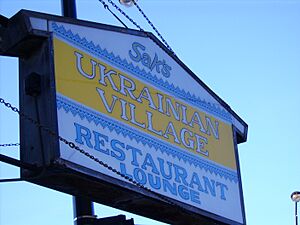
Ukrainian people live all over the Chicago metropolitan area. But Ukrainian Village has been a main gathering spot for them since the early 1900s. It's still a very important place for the community today. The neighborhood has three big Ukrainian churches. It also has Ukrainian banks and a Ukrainian language school. You can find the Ukrainian National Museum here. There's also a Ukrainian Cultural Center and the Ukrainian Institute of Modern Art. Plus, there are many Ukrainian restaurants, stores, and businesses.
For the last 50 years, Ukrainian Village has been a middle-class neighborhood. Many older people from Eastern Europe live here. The strong community and churches have helped keep the area stable. Even though other nearby areas have faced challenges, Ukrainian Village has stayed strong. It is still the heart of Chicago's large Ukrainian community. However, the West Town, Chicago area is changing. More new people are moving in. Still, about 15,000 ethnic Ukrainians call this neighborhood home.
Other important places in the area include Ss. Volodymyr and Olha Ukrainian Catholic Church. There's also St. Nicholas Ukrainian Catholic Cathedral. You can find St. Volodymyr Ukrainian Orthodox Cathedral too. Roberto Clemente High School and St Mary's Hospital are also in the neighborhood. Don't forget Holy Trinity Russian Orthodox Cathedral. This church was designed by the famous architect Louis Sullivan.
Churches in Ukrainian Village
Ukrainian Village has several churches. Many of them are very close to each other. Three are even on the same street!
St. Nicholas Ukrainian Catholic Cathedral
The story of Ukrainians in Chicago began in the late 1890s. Immigrants from western Ukraine arrived then. St. Nicholas Ukrainian Catholic Cathedral was the first of two Ukrainian Greek Catholic churches in the village. This church was home to the famous Lysenko Chorus. This choir won first place in a big singing contest in 1930. The Chicago Tribune newspaper sponsored the contest.
Sts. Volodymyr and Olha Ukrainian Catholic Parish in Chicago
Sts. Volodymyr and Olha Ukrainian Catholic Parish was started in 1968. It was founded by Patriarch Josyf Slipyj and Bishop Yaroslav Gabro. They wanted to keep the traditions of the Ukrainian Church alive. This church follows the Julian Calendar. It also has a special way of worship and unique spiritual customs.
St. Volodymyr Ukrainian Orthodox Cathedral
St. Volodymyr Ukrainian Orthodox Cathedral represents Eastern Orthodox Christianity. This is the main religion in Ukraine. This church helps new immigrants who have come from Ukraine since the Soviet Union ended. The church was first built for a German church group. It was sold twice before the current Ukrainian group bought it. The church also has a Saturday school. Students from preschool to 10th grade can learn the Ukrainian language there.
Ukrainian Village Landmark District
On December 4, 2002, a special part of Ukrainian Village became a Chicago Landmark District. This area centers on Haddon Avenue, Thomas Street, and Cortez Street. It includes parts of Damen, Hoyne, and Leavitt Avenues. Being a landmark district means these buildings and streets are protected. They are important to the city's history. More parts of the district were added in 2005 and on April 11, 2007.
Gallery
-
Street sign marking a street named after a famous Ukrainian religious leader


